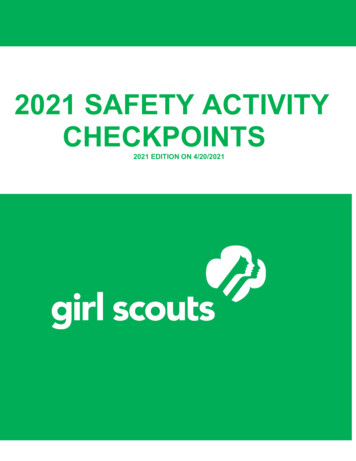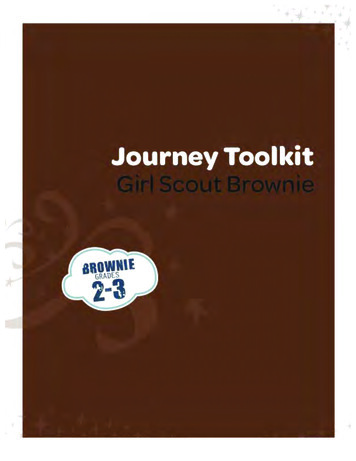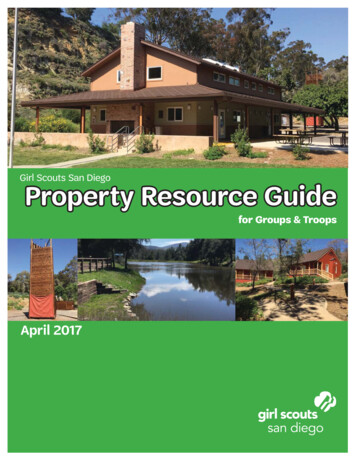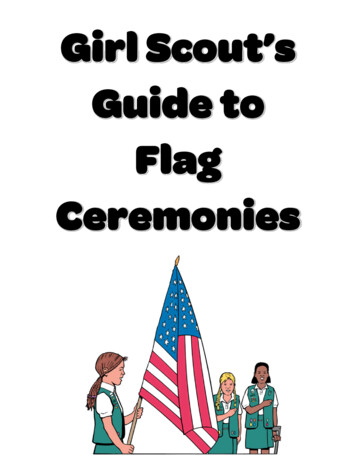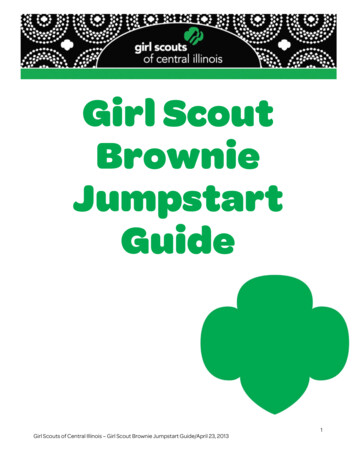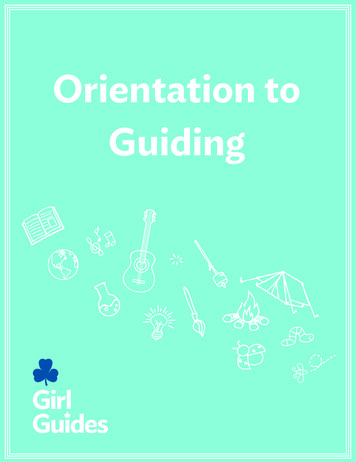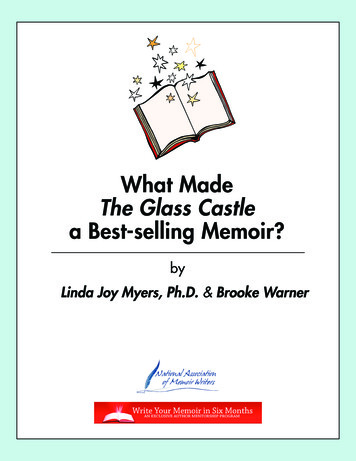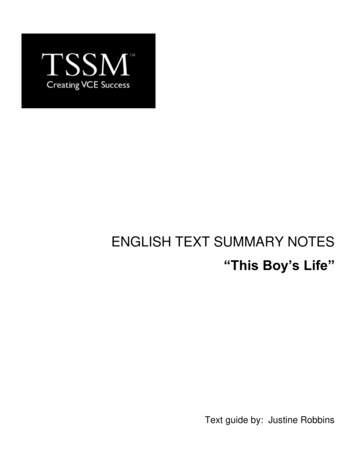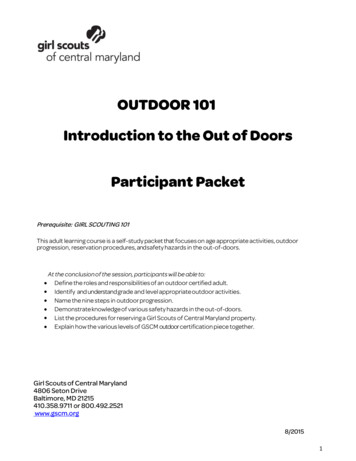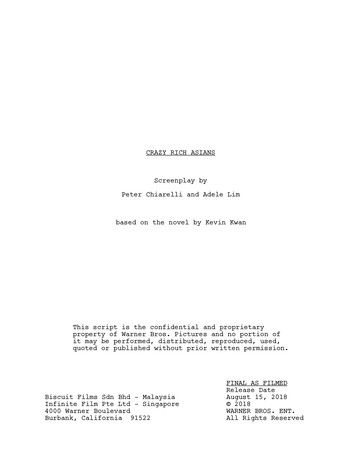
Transcription
Unit 1MemoirBrown Girl Dreamingby Jacqueline WoodsonGRADE 4 Core Knowledge Language Arts Teacher Guide
Unit 1MemoirBrown Girl Dreamingby Jacqueline WoodsonTeacher GuideGRADE 4Core Knowledge Language Arts
The Brown Girl Dreaming Teacher Guide was made possible with support from the Charles and LynnSchusterman Family Foundation.We would also like to thank Dr. Emily Chiariello (http://www.chiariello-consulting.com/)and Dr. Ebony Thomas (http://scholar.gse.upenn.edu/thomas) for their review of this Teacher Guide and fortheir insights and recommendations for resources and revisions, which have greatly enhanced this TeacherGuide. We also thank Robin McClellan and the teachers and coaches of Sulllivan County.This OER unit is offered as a supplement to the core CKLA program developed by the Core KnowledgeFoundation. The unit is not part of the current CKLA print program available for purchase from Amplify.However, as we gather more feedback on how this unit works in classrooms, Amplify and the CoreKnowledge Foundation will consider how this unit may be incorporated into future iterations of the coreCKLA program sold by Amplify.Creative CommonsLicensing This work is licensed under aCreative Commons Attribution-NonCommercial-ShareAlike4.0 International License.You are free:to Share—to copy, distribute, and transmit the workto Remix—to adapt the workUnder the following conditions: Attribution—Youmust attribute the work in the following manner:This work is based on an original work of the Core Knowledge Foundation (www.coreknowledge.org) made available throughlicensing under a Creative Commons Attribution-NonCommercialShareAlike 4.0 International License. This does not in any wayimply that the Core Knowledge Foundation endorses this work.Noncommercial—You may not use this workfor commercial purposes.Share Alike—If you alter, transform, or build upon this work, youmay distribute the resulting work only under the same or similarlicense to this one.With the understanding that:For any reuse or distribution, you must make clear toothers the license terms of this work. The best way todo this is with a link to this web /4.0/Copyright 2020 Core Knowledge Foundationwww.coreknowledge.orgAll Rights Reserved.Core Knowledge Language Arts , CKLA Core Knowledge , Core Knowledge CurriculumSeries , Core Knowledge History and Geography and CKHG are trademarks of the Core KnowledgeFoundation.Trademarks and trade names are shown in this book strictly forillustrative and educational purposes and are the property of theirrespective owners. References herein should not be regarded asaffecting the validity of said trademarks and trade names.
Table of ContentsAlignment Chart 1Introduction 9Warm Up Lessons31Lesson 139Lesson 257Lesson 367Lesson 475Lesson 585Lesson 695Lesson 7105Lesson 8113Lesson 9121Lesson 10129Lesson 11139Lesson 12147Lesson 13153Lesson 14161Lesson 15169Pausing Point 1177Pausing Point 2179Beginning-of-Year Assessment Day 1181Beginning-of-Year Assessment Day 2201Beginning-of-Year Assessment Day 3223Answer Key233
Alignment to the Common Core State StandardsThe following chart indicates which lessons in the Memoir unit address content from the CommonCore State Standards (CCSS).Unit 1: Memoir123456Lessons7 8 910 11 12 13 14 15Reading Standards for LiteratureKey Ideas and DetailsSTD RL.4.1Refer to details and examples in atext when explaining what the textsays explicitly and when drawinginferences from the text.STD RL.4.2Determine a theme of a story,drama, or poem from details in thetext; summarize the text.STD RL.4.3Describe in depth a character,setting, or event in a story or drama,drawing on specific details in thetext (e.g., a character’s thoughts,words, or actions).P P P P P P P P P P P P P P PP PPP P P P P P P P P P P P PCraft and StructureSTD RL.4.4Determine the meaning of wordsand phrases as they are used in atext, including those that alludeto significant characters found inmythology (e.g., Herculean).STD RL.4.5Explain major differences betweenpoems, drama, and prose, andrefer to the structural elements ofpoems (e.g., verse, rhythm, meter)and drama (e.g., casts of characters,settings, descriptions, dialogue,stage directions) when writing orspeaking about a text.STD RL.4.6Compare and contrast the point ofview from which different stories arenarrated, including the differencebetween first- and third-personnarrations.Core Knowledge Language Arts Grade 4PP PPPAlignment Chart Unit 11
Unit 1: Memoir123456Lessons7 8 910 11 12 13 14 15Integration of Knowledge and IdeasSTD RL.4.7Make connections between thetext of a story or drama and a visualor oral presentation of the text,identifying where each versionreflects specific descriptions anddirections in the text.STD RL.4.8(Not applicable to literature)STD RL.4.9Compare and contrast thetreatment of similar themes andtopics (e.g., opposition of good andevil) and patterns of events (e.g.,the quest) in stories, myths, andtraditional literature from differentcultures.Range of Reading and Level of Text ComplexitySTD RL.4.10By the end of the year, read andcomprehend literature, includingstories, dramas, and poetry, in theGrades 4–5 text complexity bandproficiently, with scaffolding asneeded at the high end of therange.P P P P P P P P P P P P P P PReading Standards for Informational TextKey Ideas and DetailsSTD RI.4.1Refer to details and examples in atext when explaining what the textsays explicitly and when drawinginferences from the text.STD RI.4.2Determine the main idea of a textand explain how it is supported bykey details; summarize the text.STD RI.4.3Explain events, procedures, ideas,or concepts in a historical, scientific,or technical text, including whathappened and why, based onspecific information in the text.2Unit 1 Alignment ChartP PPGrade 4 Core Knowledge Language Arts
Unit 1: Memoir123456Lessons7 8 910 11 12 13 14 15Reading Standards for Foundational SkillsPhonics and Word RecognitionSTD RF.4.3Know and apply grade-level phonicsand word analysis skills in decodingwords.P PPP P P P P P PSTD RF.4.3aUse combined knowledge of allletter-sound correspondences,syllabication patterns, andmorphology (e.g., roots and affixes)to read accurately unfamiliarmultisyllabic words in context andout of context.P PPP P P P P P PSTD RF.4.4Read with sufficient accuracy andfluency to support comprehension.P PPP P P P P P PSTD RF.4.4aRead on-level text with purpose andunderstanding.P PPP P P P P P PSTD RF.4.4cUse context to confirm or selfcorrect word recognition andunderstanding, rereading asnecessary.P PPP P P P P P PFluencyWriting StandardsText Types and Purposes: MemoirSTD W.4.3STD W.4.3aSTD W.4.3bWrite memoirs to develop realor imagined experiences orevents using effective technique,descriptive details, and clear eventsequences.P P P P POrient the reader by establishing asituation and introducing an authorand/or characters; organize an eventsequence that unfolds naturally.P P P P PUse dialogue and description todevelop experiences and events orshow the responses of characters tosituations.P P P P PSTD W.4.3cUse a variety of transitional wordsand phrases to manage thesequence of events.STD W.4.3dUse concrete words and phrasesand sensory details to conveyexperiences and events precisely.P P P P P P P P P P P P P PSTD W.4.3eProvide a conclusion that followsfrom the narrated experiences orevents.P P PCore Knowledge Language Arts Grade 4Alignment Chart Unit 13
Unit 1: Memoir123456Lessons7 8 910 11 12 13 14 15Production and Distribution of WritingSTD W.4.4STD W.4.5STD W.4.10Produce clear and coherent writingin which the development andorganization are appropriate to task,purpose, and audience. (Gradespecific expectations for writingtypes are defined in Standards 1–3above.)P P PWith guidance and support frompeers and adults, develop andstrengthen writing as needed byplanning, revising, and editing.(Editing for conventions shoulddemonstrate command ofLanguage Standards 1–3 up to andincluding Grade 4.)Write routinely over extended timeframes (time for research, reflection,and revision) and shorter timeframes (a single sitting or a dayor two) for a range of disciplinespecific tasks, purposes, andaudiences.P PP P P P P P P P P P P P P PSpeaking and Listening StandardsComprehension and CollaborationSTD SL.4.1STD SL.4.1aEngage effectively in a range ofcollaborative discussions (one-onone, in groups, and teacher-led)with diverse partners on Grade 4topics and texts, building on others’ideas and expressing their ownclearly.Come to discussions prepared,having read or studied requiredmaterial; explicitly draw on thatpreparation and other informationknown about the topic to exploreideas under discussion.P P P P P P P P P P P P P P PPP P PP P P P P P PSTD SL.4.1bFollow agreed-upon rules fordiscussions and carry out assignedroles.P P P P P P P P P P P P P P PSTD SL.4.1cPose and respond to specificquestions to clarify or follow up oninformation, and make commentsthat contribute to the discussionand link to the remarks of others.P P P P P P P P P P P P P P P4Unit 1 Alignment ChartGrade 4 Core Knowledge Language Arts
Unit 1: MemoirSTD SL.4.1dReview the key ideas expressedand explain their own ideas andunderstanding in light of thediscussion.STD SL.4.2Paraphrase portions of a text readaloud or information presentedin diverse media and formats,including visually, quantitatively,and orally.123456Lessons7 8 910 11 12 13 14 15Language StandardsConventions of Standard EnglishSTD L.4.1Demonstrate command of theconventions of standard Englishgrammar and usage when writingor speaking.STD L.4.1aUse relative pronouns (who, whose,whom, which, that) and relativeadverbs (where, when, why).STD L.4.1bForm and use the progressive (e.g.,I was walking; I am walking; I will bewalking) verb tenses.STD L.4.1cUse modal auxiliaries (e.g., can, may,must) to convey various conditions.STD L.4.1dOrder adjectives within sentencesaccording to conventional patterns(e.g., a small red bag rather than ared small bag).STD L.4.1eForm and use prepositional phrases.STD L.4.1fProduce complete sentences,recognizing and correctinginappropriate fragments and runons.STD L.4.1gCorrectly use frequently confusedwords (e.g., to, too, two; there, their).STD L.4.2Demonstrate command of theconventions of standard Englishcapitalization, punctuation, andspelling when writing.STD L.4.2aUse correct capitalization.STD L.4.2bUse commas and quotationmarks to mark direct speech andquotations from a text.STD L.4.2cUse a comma before a coordinatingconjunction in a compoundsentence.Core Knowledge Language Arts Grade 4P P P P P P P P P P P P P P PPP P PAlignment Chart Unit 15
Unit 1: MemoirSTD L.4.2d123456Lessons7 8 910 11 12 13 14 15Spell grade-appropriate wordscorrectly, consulting references asneeded.P P PKnowledge of LanguageSTD L.4.3Use knowledge of language andits conventions when writing,speaking, reading, or listening.P P P P P P P P P P P P P P PSTD L.4.3aChoose words and phrases toconvey ideas precisely.P P P P P P P P P P P P P P PSTD L.4.3bChoose punctuation for effect.STD L.4.3cDifferentiate between contextsthat call for formal English (e.g.,presenting ideas) and situationswhere informal discourse isappropriate (e.g., small-groupdiscussion).P P P P P P P P P P P P P P PVocabulary Acquisition and UseSTD L.4.4STD L.4.4aSTD L.4.4bSTD L.4.4cSTD L.4.5Determine or clarify the meaningof unknown and multiple-meaningwords and phrases based on Grade4 reading and content, choosingflexibly from a range of strategies.Use context (e.g., definitions,examples, or restatements in text) asa clue to the meaning of a word orphrase.Use common, grade-appropriateGreek and Latin affixes and roots asclues to the meaning of a word (e.g.,telegraph, photograph, autograph).Consult reference materials (e.g.,dictionaries, glossaries, thesauruses),both print and digital, to find thepronunciation and determine orclarify the precise meaning of keywords and phrases.PPP P P PP PPP P P P P P P P P P P P P P PDemonstrate understandingof figurative language, wordrelationships, and nuances in wordmeanings.PSTD L.4.5aExplain the meaning of simplesimiles and metaphors (e.g., as prettyas a picture) in context.PSTD L.4.5bRecognize and explain the meaningof common idioms, adages, andproverbs.6Unit 1 Alignment ChartPGrade 4 Core Knowledge Language Arts
Unit 1: MemoirSTD L.4.5cSTD L.4.6Demonstrate understanding ofwords by relating them to theiropposites (antonyms) and towords with similar but not identicalmeanings (synonyms).Acquire and use accurately gradeappropriate general academic anddomain-specific words and phrases,including those that signal preciseactions, emotions, or states of being(e.g., quizzed, whined, stammered)and that are basic to a particulartopic (e.g., wildlife, conservation, andendangered when discussing animalpreservation).Core Knowledge Language Arts Grade 412P3456Lessons7 8 910 11 12 13 14 15PPP P P P P P P P P P P P P P PAlignment Chart Unit 17
8Unit 1 Alignment ChartGrade 4 Core Knowledge Language Arts
IntroductionUnit 1: Memoir: Brown Girl DreamingINTRODUCTION TO CKLA PROGRAMWelcomeDear Grade 4 Teacher,Welcome to the Core Knowledge Language Arts (CKLA) program! This K–5 program has beencarefully researched and designed to ensure students acquire the knowledge and skills foundationneeded to become literate adults (i.e., college and career ready), as called for in the Common CoreState Standards (CCSS)-ELA.Individuals familiar with Grades K–3 CKLA may recall that the program in these grade levels comprisestwo strands: the Skills Strand and the Listening & Learning Strand.In Grades K–2, the two strands function autonomously. In the Skills Strand, students developcomprehensive decoding abilities through explicit, systematic instruction in phonics, and honespelling, grammar, and writing skills. In the Listening & Learning Strand, students are exposed dailyto challenging, complex text through carefully sequenced domain-based read-alouds at a time whenthey are they unable to read comparable text on their own. This approach ensures students arebuilding much-needed oral language skills, as well as vocabulary and content knowledge.In the Grade 3 units, the Skills Strand texts and the Listening & Learning Strand read-aloudsconsistently complement one another in terms of domain-based content. By Grade 3, students whohave received CKLA instruction typically have both the basic and advanced code knowledge neededto decode nearly all possible letter-sound correspondences in the English language. At this point,when students encounter words with spellings that may not have been taught explicitly, they shouldbe able to analyze these words based on existing code knowledge and make inferences about wordsand phrases using the surrounding text. This decoding automaticity allows students to devote greaterattention to comprehension, fluency, and continued vocabulary acquisition.By Grade 4, students should be able to independently read increasingly complex text, as well asrespond in writing to these same texts. As such, in Grade 4 CKLA, there are no longer two separatestrands of instruction. Instead, the program includes a combination of features from both the SkillsStrand and Listening & Learning Strand. Each unit includes explicit instruction and practice in writing,grammar, morphology, and spelling, as well as reading. These materials, as well as how and when touse them, are described below.Core Knowledge Language Arts Grade 4Introduction Unit 19
GRADE 4 CKLAComponentsThe CKLA Grade 4 program includes the following components: Teacher Guide Reader (or Trade Book) Activity Book Fluency Supplement (online) Decoding and Encoding Remediation Supplement (online)In addition, teachers should ensure that grade-appropriate writing paper and/or notebooks are readilyavailable to students.Whenever a lesson suggests displaying materials (such as an activity page), please choose the mostconvenient and effective method to reproduce and display the material. Some suggestions includemaking a transparency of the material and using an overhead projector; scanning the page andprojecting it on an interactive electronic surface; or writing the material on the board/chart paper.Teacher ComponentsTeacher GuideEach Teacher Guide includes daily lessons that provide detailed directions for comprehensive languagearts instruction. Lessons, instruction, and exercises in the Teacher Guide should be taught in the orderlisted. The lessons also suggest group sizes for instruction and exercises (e.g., whole group, smallgroup, partners, independent). You should use your discretion in following the grouping suggestions andconsider students’ needs.In addition to detailed reading instruction, lessons in the following areas of study are also taught inGrade 4:10 Writing: Writing instruction begins in Unit 1. It centers on a comprehensive writing process andfocuses on writing increasingly complex sentences, composing coherent paragraphs, and writingfor a variety of purposes that align with the CCSS-ELA. Morphology: Explicit morphology instruction begins in Unit 2, and addresses reading andunderstanding words with common prefixes, suffixes, and Greek and Latin roots. Morphologyinstruction also addresses the meaning of various prefixes, suffixes, and roots. Knowledge ofthese prefixes, suffixes, and roots builds students’ vocabulary and enhances their ability to readunfamiliar multi-syllabic words. Grammar: Specific grammar lessons and exercises begin in Unit 2 and address various speech andlanguage-usage conventions (such as capitalization and punctuation) as identified in the CCSS-ELA.Knowledge of these specific grammar skills are then reinforced and applied in all writing exercises.Unit 1 IntroductionGrade 4 Core Knowledge Language Arts
Spelling: Explicit spelling instruction begins in Unit 2. Weekly word lists and accompanyingexercises focus on content words and words with morphological patterns taught in the unit.Each week concludes with a spelling assessment. The spelling exercises provide students withopportunities to practice applying knowledge of letter-sound correspondences learned in earliergrades. The weekly assessment can be a useful indication of which students may have gaps incode knowledge and require remediation.The lessons in Unit 1 focus intensively on reading and writing, in order to immerse students in CKLAroutines as they return to school after summer break. Explicit instruction in morphology, grammar, andspelling, is important in satisfying all aspects of the CCSS-ELA, and starts in Unit 2.Student ComponentsCKLA Reader or Trade BookThe Readers conform to the standard readability criteria for Grade 4 as outlined by the CCSS- ELA.Each Reader includes core chapters for the lessons, as well as supplemental chapters that may beused for enrichment. Teacher-directed lessons for the enrichment chapters, which begin in Unit 2,are not included in the Teacher Guide; please use these selections at your discretion, consideringstudents’ needs and the time available in your school day.For some units, including Unit 1, each student will receive a trade book instead of a Reader. In theseunits, pages or lines of text in the trade book are not reproduced in the Teacher Guide. Instead, theTeacher Guide will direct you to reference certain pages and/or lines of text as students work with thetrade books.Activity BookEvery unit includes a collection of activity pages. These instructional exercises are used in differentways. Some pages are designed to be completed with your assistance, whereas others are intendedto be completed independently, either in class or for homework. In addition to activity pages that aredesigned to reinforce skills, some include take-home excerpts of Reader chapters and take-home listsof spelling words.The Teacher Guide for each unit provides explicit direction in each lesson as to when and how touse the activity pages. Please note that activity pages are organized and numbered according to thelesson number and the order in which they are used within the lesson. For example, if there are twoactivity pages for Lesson 4, the first will be numbered 4.1 and the second 4.2.Additionally, there are resources at the very end of the activity pages. The pages are labeled asStudent Resources, SR.1, SR.2, etc. Included in these resources are charts to which studentswill be directed to refer (e.g., glossary), as well as the pages needed for the Beginning of the YearAssessment, labeled as A.1, A.2, etc.Core Knowledge Language Arts Grade 4Introduction Unit 111
Other ComponentsFluency Supplement (online)Helping students achieve automaticity and fluency to improve reading comprehension is an importantgoal in CKLA Grade 4. The optional Fluency Supplement, consisting of poetry, folklore, fables, andother selections, is provided online at CKLA Ancillary Materials: Fourth Grade (URL: ncillary-materials-fourth-grade/). These selections provideadditional opportunities for students to practice reading with fluency and expression (prosody). Youmay choose and use the selections at your discretion in any order or frequency.There are sufficient selections so you may, if desired, use one selection per week for fluency practice.One possible approach is to copy and distribute a selection to students at the beginning of eachweek. You should model reading the selection aloud with prosody (intonation, tone, rhythm). Studentsmay then take the selection home to practice reading aloud throughout the week with the expectationthat they be prepared to read the selection fluently and with prosody by the end of the week. At theend of the week, you would select a few students to read the selection aloud, either individually orchorally. This process allows you opportunities to hear different students read aloud each week. If youuse this approach, you should establish audience guidelines for students. Some ideas for audienceguidelines include: Listen respectfully to your classmates. Listen without talking. Give your classmate(s) a round of applause and sincere compliments on their reading (e.g., “I likedit when you . . .”)Decoding and Encoding Remediation Supplement (online)Comprehensive, explicit, and systematic instruction in letter-sound correspondences (i.e., decodingand encoding) is provided in Grades K–2 CKLA. However, some students entering Grade 4 CKLA maynot have had the benefit of that early instruction and may still struggle with decoding and/or encodingwords. A separate online publication, the Decoding and Encoding Remediation Supplement, providesfurther guidance in assessing, analyzing, and remediating specific skills related to decoding and lettersound correspondences.This Decoding and Encoding Remediation Supplement can be found online at ncillary-materials-fourth-grade/. Refer to this supplement foradditional resources, mini-lessons, and activities to assist students who experience difficulty withdecoding and letter-sound correspondences.Beginning of the Year AssessmentUnit I includes a Beginning-of-Year Assessment, that will aid you in determining whether students haveadequate preparation for Grade 4 CKLA instruction. Students with significantly below grade-level gapsin letter-sound knowledge require intensive decoding instruction on their level, ideally by a readingspecialist, to bring them up to grade level. The Decoding and Encoding Remediation Supplement is notintended for use with these significantly below grade- level students. It is, however, designed to providetargeted remedial instruction to students who may occasionally struggle with gaps in letter-soundknowledge, as evidenced by occasional problems in reading and/or spelling entire or parts of words.12Unit 1 IntroductionGrade 4 Core Knowledge Language Arts
UNIT INTRODUCTION: MEMOIR – BROWN GIRL DREAMINGThe first unit of Grade 4 CKLA instruction contains a warm up lesson, followed by 15 daily lessons,each of which intentionally focuses only on reading and writing. In this way, students are immediatelyimmersed in CKLA reading and writing routines during their first few weeks back in school aftersummer break. Each lesson will require a total of 90 minutes. (As noted earlier in this introduction,explicit instruction in morphology, grammar, and spelling, which are important in satisfying all aspectsof the CCSS-ELA, start in Unit 2.) Following the completion of the Brown Girl Dreaming lessons,several culminating activities are suggested from which teachers may choose.After completing all of the above lessons and activities in this unit, you will administer the Beginningof-Year Assessment. We recommend you spend no more than three days total on the assessment.Why This Unit Is ImportantThis unit is based on the book Brown Girl Dreaming by Jacqueline Woodson. The book begins withMs. Woodson’s birth in February, 1963 in Ohio. An African American woman, Ms. Woodson wasborn in the midst of the 1960s Civil Rights Movement in the United States. Students who completedthe Grade 2 CKLA domain, Fighting for a Cause, may recall the historical context needed to fullyunderstand the nuances of Ms. Woodson’s memoir. We have attempted to include additional teacherprompts to assist you in supporting students who may lack this background knowledge.Although this text may be a challenge in terms of content and Lexile level for students at the beginningof the academic year, Brown Girl Dreaming is noteworthy for many reasons. The author describesin emotionally charged and evocative language the life of an African American girl growing up inthe South and in New York in the 1960s and 1970s during a pivotal period of American history. Thebook has received numerous recognitions, including the following: The Newberry Medal Honor BookAward; National Book Award for Young People’s Literature; the NAACP Image Award for OutstandingLiterature; and the Coretta Scott King Book Awards Author. Ms. Woodson was also named the 20182019 National Ambassador for Young People’s Literature.This unit is difficult to classify in terms of a single literary genre. We have identified the unit as amemoir since the author reflects on and writes about her experiences and the historical context duringwhich she grew up as a young girl. This memoir is, however, unique in that the selections are written infree verse; some might therefore also classify this book and unit as poetry.Students will focus on identifying, describing, and using elements of a memoir both in reading andwriting. These elements include stories told from the first-person point of view; stories focusing on oneor more events or experiences important to the author; and descriptive language using sensory detailsand figurative language.Through books such as Brown Girl Dreaming, students will begin to explore the issues of individualidentity, connections to family and the wider community, and issues of tolerance. To minimize thechallenges presented by a higher-Lexile text, not all selections in this book are read. In addition,many of the selections are read a second time, with a great deal of scaffolding to help students gaina deeper understanding of the selections. Finally, many supports are also presented in this TeacherGuide to help students as they are presented with emotionally- charged issues such as slavery andracism.Core Knowledge Language Arts Grade 4Introduction Unit 113
Core Content Objectives Addressed in Core Knowledge Language Arts during PreviousGradesStudents who have received Core Knowledge Language Arts (CKLA) instruction in Grades K–3 willalready have pertinent background knowledge for this unit. For students who have not received priorCKLA instruction, introductory knowledge with particular focus on the bolded objectives below will behighlighted in the Core Connections section of Lesson 1; additional suggestions are provided to buildbackground knowledge, if class time permits.Nursery Rhymes and Fables (Kindergarten) Describe the characters and/or events in nursery rhymes and fables Identify rhyming words in nursery rhymes Identify lines that repeat in nursery rhymes Identify dialogue in nursery rhymes and fables Explain that fables teach a lesson that is stated as the moral of the story Identify the moral of a given fable Explain how animals often act as people in fables (personification)Stories (Kindergarten) Explain that stories that are made-up and come from a writer’s imagination are called fiction Identify the beginning, middle, and end of a given story Identify the sequence of events in a given story Identify the characters of a given story Identify the plot of a given story Identify the setting of a given story Identify the characteristics of subgenres of fiction, including folktales and trickster talesFables and Stories (Grade 1) Identify character, plot, and setting as basic story elements Describe the characters, plot, and setting of a specific fable or story Identify fables and folktales as types of fiction Identify characteristics of fables: short, moral, personification Explain in their own words the moral of a specific fableDifferent Lands, Similar Stories (Grade 1) Explain that fictional stories come from the author’s imagination Identify folktales as a type of fiction Explain that stories have a beginning, middle, and end Describe the characters, plot, and setting of a given story Explain that people from different lands and cultures tell similar stories14Unit 1 IntroductionGrade 4 Core Knowledge Language Arts
Fairy Tales (Grade 1) Identify the fairy tale elements of specific fairy tales Identify fairy tales as a type of fiction Identify common characteristics of fairy tales, such as “once upon a time” beginnings, royalcharacters, elements of fa
Alignment Chart 1 Introduction 9 Warm Up Lessons 31 Lesson 1 39 Lesson 2 57 Lesson 3 67 Lesson 4 75 Lesson 5 85 Lesson 6 95 Lesson 7 105 Lesson 8 113

